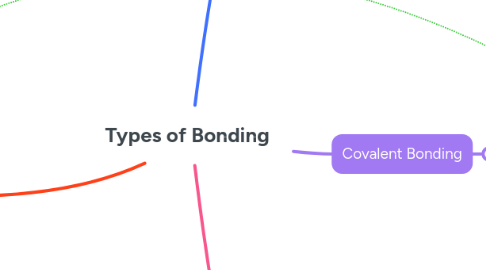
1. Ionic Bonding
1.1. metal and non-metal atoms
1.2. metal gives and non-metal takes electrons to become ions and be stable
1.2.1. Can conduct electricity if melted or dissolved as these states have free moving ions. No conductivity as solid since ions are static in the 3D lattice.
1.3. create 3D lattice of ions where position of ions matter - directional
1.3.1. Applied force can push ions of the same charge close together
1.3.1.1. Like charged ions repel causing the ionic bonds to break and the substance shatters = Brittle
1.4. strong, electrostatic atrraction between oppositely charged ions
1.4.1. requires high heat energy to break so melting points for ionic substances are high.
2. Covalent Bonding
2.1. Only non-metal atoms
2.2. the non-metal atoms share electrons to be stable
2.3. creates molecules, which are discrete packages of non metal atoms
2.3.1. Molecules can be polar or non-polar depending on the electronegativity differences of the non-metal atoms.
2.3.1.1. Polar molecules dissolve in polar water, whilst non polar molecules do not.
2.4. creates giant networks
2.4.1. Diamond
2.4.1.1. Each C bonded to 4 others creating a 3D tetrahedral network
2.4.2. Graphite
2.4.2.1. Each C bonded to 3 others creating 2D layers with free electrons.
2.4.2.1.1. Can conduct electricity due to free moving electrons
2.4.3. Silicon Dioxide
2.4.3.1. Each Si bonded to 4 O atoms in a 3D network.
2.5. very strong attraction due to 'tug of war' for shared electrons by each atom's nucleus
3. Metallic Bonding
3.1. only metal atoms
3.2. metal atoms become cations with free moving valence electrons
3.2.1. can conduct electricity due to free moving electrons
3.3. 3D lattice of cations and delocalised electrons where position of particles does NOT matter - non-directional
3.3.1. Applied force just shuffles the particles around and they remain attracted to one another
3.3.1.1. This causes the metal to bend of stretch easily - malleable and ductile.
3.4. strong attraction between cations and free moving electrons
3.4.1. requires high heat energy to break so melting points for metallic substances are high.
